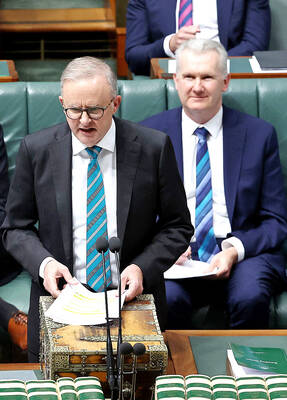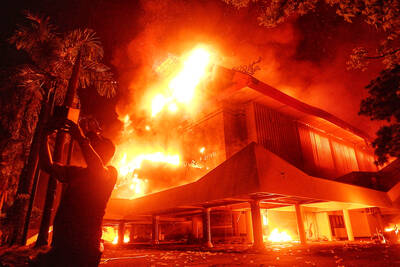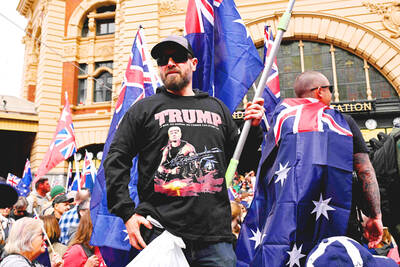Britney Spears is probably not the likeliest muse for a work of art promoting an anti-abortion message. Yet hard as it may be to imagine her inspiring such meditations, it is no stretch at all to imagine that a gallery show including a politically tinged likeness of Spears is apt to draw a bit of attention.
That appears to be the strategy, anyway, behind a life-size clay sculpture by a 40-year-old Connecticut artist, Daniel Edwards, that depicts Spears giving birth.
The sculpture titled, Monument to Pro-Life: The Birth of Sean Preston, depicts Spears on her knees and elbows giving birth atop a bearskin rug.

PHOTO: EPA
It will be shown publicly at an exhibition that is opening next Friday at Capla Kesting Fine Art gallery in Brooklyn.
When asked how he chose Spears as his subject from among the thousands of women who give birth each day, Edwards said: She's the highest profile. She was the best choice. I couldn't come up with anybody that matched her.
The clay sculpture is meant to represent the day last September when Spears gave birth to her son, Sean Preston Federline.
For the last week or so, blog-gers have been weighing in on the sculpture, with comments ranging from disapproval to disbelief, with some calling it all a publicity ploy.
An anti-abortion group whose literature will be included at the opening has backed away from the work, and the gallery holding the opening has been flooded with messages, pro and con, remarking on the sculpture.
Edwards said he did not speak with Spears before creating the sculpture. Leslie Sloan Zelnik, a spokeswoman for Spears, did not return a call on Wednesday seeking comment.
Edwards resisted characterizing himself as anti-abortion, but said he believed that life began "at conception."
The sculptor said that the image of Spears giving birth was a beautiful way to present the anti-abortion message, in contrast to the grisly images like fetuses in jars that are sometimes used by anti-abortion groups.

Australia has announced an agreement with the tiny Pacific nation Nauru enabling it to send hundreds of immigrants to the barren island. The deal affects more than 220 immigrants in Australia, including some convicted of serious crimes. Australian Minister of Home Affairs Tony Burke signed the memorandum of understanding on a visit to Nauru, the government said in a statement on Friday. “It contains undertakings for the proper treatment and long-term residence of people who have no legal right to stay in Australia, to be received in Nauru,” it said. “Australia will provide funding to underpin this arrangement and support Nauru’s long-term economic

ANGER: Unrest worsened after a taxi driver was killed by a police vehicle on Thursday, as protesters set alight government buildings across the nation Protests worsened overnight across major cities of Indonesia, far beyond the capital, Jakarta, as demonstrators defied Indonesian President Prabowo Subianto’s call for calm. The most serious unrest was seen in the eastern city of Makassar, while protests also unfolded in Bandung, Surabaya, Solo and Yogyakarta. By yesterday morning, crowds had dispersed in Jakarta. Troops patrolled the streets with tactical vehicles and helped civilians clear trash, although smoke was still rising in various protest sites. Three people died and five were injured in Makassar when protesters set fire to the regional parliament building during a plenary session on Friday evening, according to

‘NEO-NAZIS’: A minister described the rally as ‘spreading hate’ and ‘dividing our communities,’ adding that it had been organized and promoted by far-right groups Thousands of Australians joined anti-immigration rallies across the country yesterday that the center-left government condemned, saying they sought to spread hate and were linked to neo-Nazis. “March for Australia” rallies against immigration were held in Sydney, and other state capitals and regional centers, according to the group’s Web site. “Mass migration has torn at the bonds that held our communities together,” the Web site said. The group posted on X on Saturday that the rallies aimed to do “what the mainstream politicians never have the courage to do: demand an end to mass immigration.” The group also said it was concerned about culture,

CRACKDOWN: The Indonesian president vowed to clamp down on ‘treason and terrorism,’ while acceding to some protest demands to revoke lawmaker benefits Protests in Indonesia over rising living costs and inequality intensified overnight, prompting Indonesian President Prabowo Subianto to cancel a planned trip to China, while demonstrators reportedly targeted the homes of the finance minister and several lawmakers. Rioters entered Indonesian Minister of Finance Sri Mulyani Indrawati’s residence near Jakarta early yesterday, but were repelled by armed forces personnel, Kompas reported. Items were taken from the homes of lawmaker Ahmad Sahroni and two others, according to Detik.com. The reports of looting could not be independently verified, and the finance ministry has not responded to requests for comment. The protests were sparked by outrage over